Happy Easter!

Now is the time for all good bunnies to come hopping out of
the woodwork and drop brightly colored eggs into the bushes, singing,
"It's Easter, and springtime, lalala..."
Oh, sorry. Sometimes you can get carried away with this stuff,
just like it seems they did in ancient times...
 First, let's look at Eggs.
Eggs are an Easter tradition, and used day in and day out throughout
the year. It is probably the most consumed item in the United
States, and has symbolism in many different cultures as well.
For example, Jews use eggs dipped in saltwater during passover
to symbolize the tears shed by the ancestors during their slavery
days in Ancient Egypt.
First, let's look at Eggs.
Eggs are an Easter tradition, and used day in and day out throughout
the year. It is probably the most consumed item in the United
States, and has symbolism in many different cultures as well.
For example, Jews use eggs dipped in saltwater during passover
to symbolize the tears shed by the ancestors during their slavery
days in Ancient Egypt.
The American Heart Association says that eggs are high in
cholesterol, and many egg substitutes came on the market. Eggbeaters,
etc, gave us the taste of eggs, but somehow Eggbeaters never replaced
the Easter Egg. I mean, powdered eggs just don't hold dye very
well.
Let's look at some other traditions for eggs (and baskets,
too):
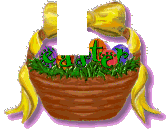
Early Easter baskets were made to look like bird's nests.
In ancient times, people placed their Easter eggs in grass nests
to honor the ancient goddess Easter. Later, woven baskets filled
with straw took the place of nests. Today, Easter baskets are
decorated with ribbons, flowers, and real or artificial straw.
They are filled with eggs, both dyed and filled with treats, jelly
beans, and other Easter gifts and sweets. A chocolate rabbit or
yellow marshmallow chick is welcomed in a basket on Easter morning.
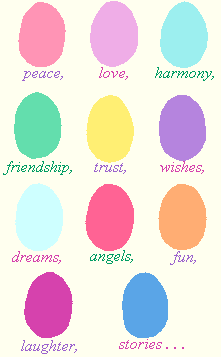
Many of the Easter customs come from Europe. There, Easter
eggs have been decorated for hundreds of years, and are said to
be brought to children by the Easter rabbit.
Usually the eggs used for dyeing or painting are chicken's
eggs. But some early people celebrated the beginning of spring
by dancing around a pile of snakes eggs. On the first day of spring,
the people of ancient Persia gave each other eggs dyed red. Colored
eggs were used in celebration by the ancient Egyptians as well
as by the Greeks and Romans. Among the Chinese, the parents of
newborn children still present gifts of eggs to their friends.
(The sign of good fortune.) Around the world, the egg, like the
seed, is a sign of life.
In England, decorated Easter eggs are sometimes referred to
as Pace eggs. "Pace" is a form of the term paschal.
Paschal comes from the "Pasch" a name for Easter that
comes from the Hebrew word for Passover, or "Pesach."
The name for Easter in many places is related to this word. Easter
is called "Paques" in France, "Pasqua" in
Italy, and "Pascua" in Spain and other Spanish-speaking
countries.
In eastern and central Europe, Easter eggs are taken very
seriously. Among the most elaborate eggs are those decorated by
people from Poland and from the Ukraine, a part of the former
Soviet Union. These people call their eggs "psyanki",
which means "written eggs".
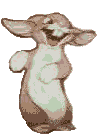
Psyanki eggs are decorated in a way that is very much like
writing. A special type of pen is used to draw designs, lines,
or pictures on the eggs with wax. The eggs are then dyed. The
dye will not take on the parts of the egg where the wax has been
placed. The dyeing may be done in several stages, with wax added
to new areas after each dye bath. When all the dyeing is finished,
the wax is melted off and the design is left. A person may spend
several days working on the design for just one egg.
Other national groups have their own way of making Easter
eggs. The Pennsylvania Dutch dye their eggs with colors made from
natural materials such as bark or onion skin. They scratch the
shells with sharp knives or needles. The points scrape away a
little of the dye and make lacy patterns on the shells. A very
time-consuming but rewarding process!
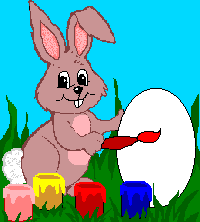
The most elaborate Easter eggs of all are not even real eggs.
A jeweler named Carl Faberge lived in Russia about one hundred
years ago. Faberge made his eggs out of gold, silver and jewels.
At Easter time, the Russian tsar gave these eggs as gifts to friends
and family members. Faberge eggs almost always open up
to show a surprise - perhaps tiny figures of people, animals,
plants, or buildings.
Most people today make simpler Easter eggs. The Easter colors
are often used. These are the pastel colors of springtime or else
fresh colors like robins egg blue, pale yellow, violet, or light
green. Nowadays, you can find purples, pinks, oranges; truly there
are no limits to your imagination! Sometimes people hang Easter
eggs on an egg tree. First, the eggs are pierced with a large
needle and the contents are blown out of them. Ribbons or strings
are then passed through the holes to tie them to the tree. The
Pennsylvania Dutch set up the first egg tree.

We owe the custom of the Easter Monday egg roll to America's
fourth president, James Madison, and his wife. Dolly Madison's
son John Payne Todd should probably get the credit for it. He
told his mother that the children of ancient Egypt had rolled
eggs outside the pyramids. That piece of information is probably
not true. But President James and Dolly Madison did start the
custom of an annual Easter egg roll. They held it on the lawn
of the Capitol building in Washington in the early 1800s.

During the Civil War, the Easter egg roll was stopped. But
after the war, the custom was resumed. In the late 1870s, President
and Mrs. Rutherford B. Hayes moved the holiday game to the South
Lawn of the White House. Children rolled eggs down a hill to see
which egg will go the farthest without breaking. Sometimes during
an egg-rolling contest, eggs have to pass through a series of
hoops. In 1953, President Dwight D. Eisenhower revived the White
House Easter egg roll, which had been stopped during World War
II. Another Easter egg roll is often held in New York City's Central
Park sometime during the Easter season.

Cool Links!!
These pages maintained and created by Khris Comstock, {Webmaster},
last update September, 2001. All graphics on this site come
from either Xoom Software, or are free graphics. If any belong
to you, and I do not have individual copyright info under it,
please e-mail me so
I can change the graphic or include copyright info! Thanks.
You are the visitor to this page.
This page hosted by Get your own Free
Home Page





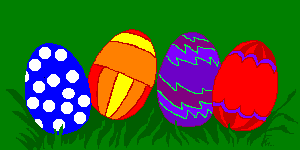 New Year's Day
New Year's Day